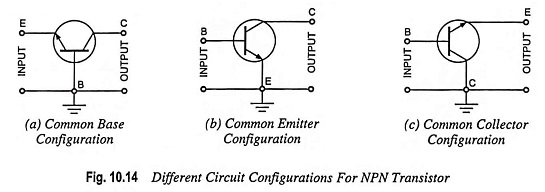Transistor Circuit Configurations (CB, CE, CC):
As already mentioned, a Transistor Circuit Configurations is a three-terminal device (having three terminals namely emitter, base and collector) but we require four terminals—two for the input and two for the output for connecting it in a circuit. Hence one of the terminals of the transistor is made common to the input and output circuits. Thus there are three types of configurations for operation of a transistor.
These Transistor Circuit Configurations are common base (CB), common emitter (CE) and common collector (CC) configurations. The term `common’ is used to denote the electrode that is common to input and output circuits. Since the common terminal is usually grounded, these configurations are also referred to as grounded base, grounded emitter and grounded collector configurations, as shown in Figs. 10.14 (a), 10.14 (b) and 10.14 (c) respectively.
Each configuration has its own merits and demerits. It is to be remembered that regardless of the circuit configurations, the emitter is always forward biased and the collector is always reverse biased.
